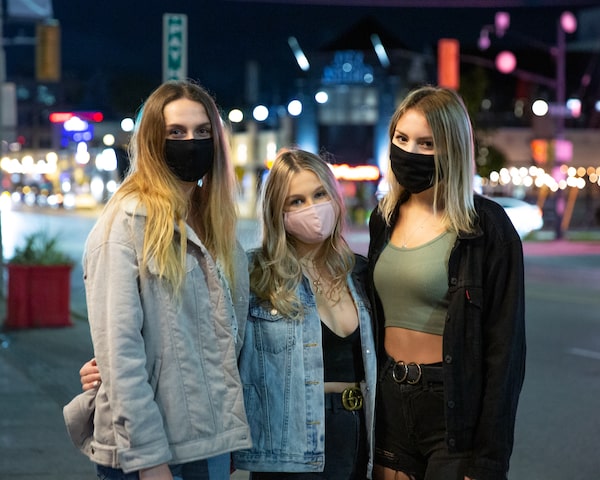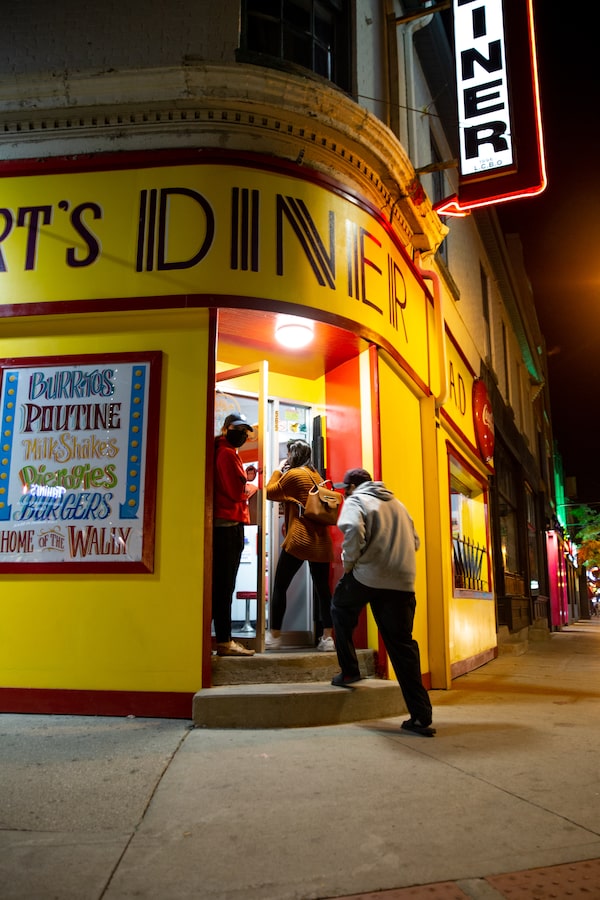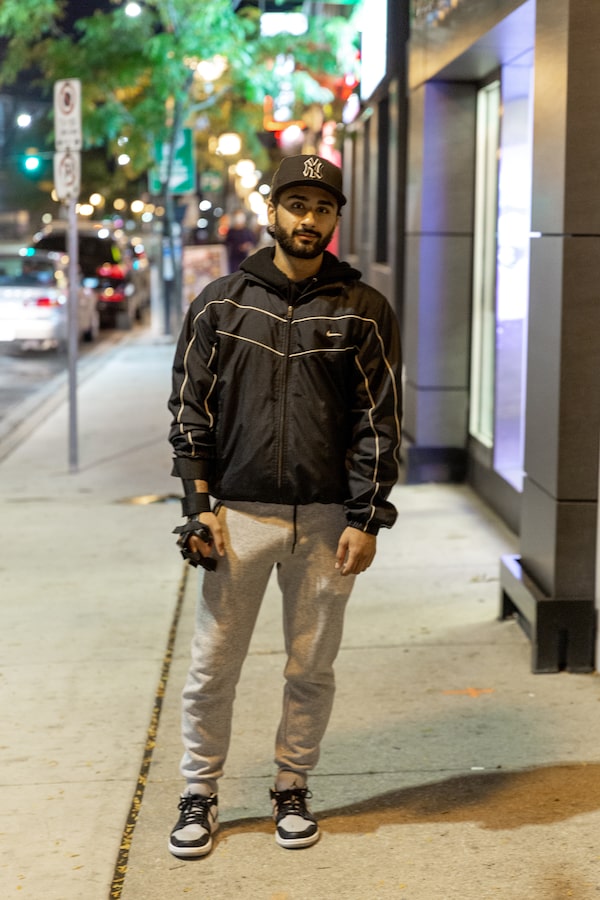
Klara, Maddie and Ally, seen here on Oct. 1, 2020, all study business at Huron University College, an affiliate college of Western. Even with all online courses and Huron’s residences closed, the trio decided to move to London for their first year to meet other students.Liam Afonso/The Globe and Mail
The notifications came three days after the Montreal meetings, first by phone and then by e-mail: An attendee was confirmed positive for COVID-19 and now everyone had to get tested.
Anthony Koch, a 22-year-old student at McGill University and a member of federal Conservative Leader Erin O’Toole’s campaign, was among the roughly 60 people who attended two private meetings on a mid-September morning. Attendees had worn masks and kept their distance in a big room.
Mr. Koch felt fine, except for maybe a slight head cold. He went and got tested as directed.
He says he was shocked to learn that he was among about 15 people – including Mr. O’Toole – to test positive.
“Everybody under the age of 40 is like me, with little to no symptoms,” Mr. Koch said.
Mr. Koch is typical of the Canadians testing positive for COVID-19 as part of a second wave that is shaping up to be very different from the first. What is different might also make it harder to control.
Driving the spread today are young adults who generally have milder symptoms and less to fear from the coronavirus than their parents and grandparents. More than 28,000 Canadian 20- to 29-year-olds have now tested positive for the virus since the start of the pandemic, but just 1.3 per cent have been admitted to hospital and 10 have died, according to the Public Health Agency of Canada (PHAC.)
While some younger COVID-19 patients suffer a long-lasting illness, the virus’s light touch on most healthy twenty-somethings is precisely what makes the age cohort dangerous. They work and socialize, often unaware they have COVID-19. Next weekend, they could unwittingly spread SARS-CoV-2 to their older relatives if they trek home for Thanksgiving.
Controlling Canada’s epidemic now hinges on persuading young adults to volunteer for a long winter of loneliness, not to protect themselves, but for the sake of others. One solution could be going public with specific details about where and how the virus is spreading among young adults, as public-health officials did in London, Ont., when back-to-school partying threatened to spiral out of control. In the university town, the threat of fines and punishment helped, too.
On a Wednesday and Thursday evening in early October, the usually popular Richmond Row in downtown London, Ont., was quieted by rain and concerns about the rise in COVID-19 cases across the province. Students here grapple with distancing rules and gauging their own risk-levels around contracting the coronavirus, while still hoping to enjoy university life.
The Globe and Mail
Governments, public-health officials and physicians are also drawing on psychological research, taking their messages to social media and enlisting the video-game industry to help get the word out.
Berating younger audiences isn’t the answer, said Naheed Dosani, a 35-year-old palliative-care physician and health-justice activist on faculty at the University of Toronto and McMaster University in Hamilton. In early March, he began posting Health Canada COVID-19 advice on TikTok in bite-sized videos set to music. His first got more than 100,000 views.
"What would probably work better [than shaming] is an approach that is positive, energizing and innovative, in a way that works for them,” Dr. Dosani said.

As cases rise and the provincial government rolls out stricter guidelines on indoor dining, students weigh the risk of exposure with the desire to leave their homes after a long day of online lectures and minimal socializing.Liam Afonso/The Globe and Mail
To understand how the demographics of COVID-19 have changed, look no further than the map of cases in Toronto, where infections soared through September. In the spring, the places hit hardest (outside of nursing homes and shelters) were in north Etobicoke, a part of Toronto where many of the residents are poor and racialized and hold jobs that can’t be done from home.
By contrast, the neighbourhood that has reported more new cases than any other over the past three weeks is the city’s waterfront and the Toronto islands, home to many condominium towers and the city’s Entertainment District. Toronto Public Health identified 153 new cases, or 232 cases per 100,000, in people living there in the three weeks leading up to Oct. 1.
The waterfront residents are wealthier and better educated than the average Torontonian, and fewer are immigrants, according to 2016 census data. Slightly more than half the recent cases in the neighbourhood were diagnosed in people in their 20s, according to a Globe analysis.
Toronto’s snapshot is in keeping with the big picture in Canada. Since June, the highest proportion of new COVID-19 cases have been diagnosed in 20- to 29-year-olds, followed by thirty-somethings. The Public Health Agency of Canada’s epidemiological summary for the week ending Sept. 19, the most recent available, noted that 64 per cent of new cases that week were in people under 40, and nearly half of those were in their 20s.
In some senses, the demographic shift is positive. It suggests that older people are better shielded from the virus, and it shows that expanded testing is identifying more cases now than in the spring, when young adults with mild COVID-19 symptoms were denied testing.
But as University of Toronto epidemiologist Ashleigh Tuite points out, it’s simply, “not feasible to contain a communicable disease to a certain group of people.” The coronavirus is likely to spread from the young to the old in Canada as it did in the southern United States, where a recent study from the Centers for Disease Control and Prevention found that spikes in cases among adults aged 20-39 were followed a few weeks later by increases in those over 60.
Michael Warner, medical director of critical care at Toronto’s Michael Garron Hospital, said it’s also important for twenty-somethings to know that even if COVID-19 doesn’t land them in a hospital, its ill effects can linger for months. "It’s not clear that people will be spared lifelong complications from COVID just because they’re young,” he said.
When Olivia McFarlane, 22, developed a fever and nausea in early March, she assumed that she had caught whatever bug her father had a few days earlier and that it would soon pass. Since then, the Toronto woman says she has also experienced extreme fatigue, sore muscles, dizziness and chest pains that have left her “unable to do anything normal."
Getting a COVID-19 test wasn’t an option at the beginning – she didn’t qualify in those early weeks – and X-rays and blood work showed nothing abnormal.
Ms. McFarlane says the scariest part of her ordeal is not knowing when, or if, she will fully recover. “Approaching seven months, I’m questioning if this is just my life now," she said.

London's Richmond Row is quieter than normal in October as COVID-19 cases rise and the provincial government rolls out stricter guidelines on indoor dining.Liam Afonso/The Globe and Mail
Richmond Row – usually the beating heart of nightlife in London, Ont. – gets quieter each weekend.
At the beginning of September, the scene wasn’t much different from any other year along the downtown strip of bars popular with students from the University of Western Ontario and Fanshawe College.
Then, about a week into classes, student infections spiked. Five cases among students became 39, and the Middlesex-London Health Unit went public with a detailed contact-tracing graphic explaining how one of the clusters, traced to a student bar called Lost Love Social House, had spread. A second cluster was traced to a single house party in a student neighbourhood bordering the Western campus.
Now the bars of Richmond Row are the quietest they’ve been in years, said Dean, a fourth-year geography student at Western. (The Globe and Mail agreed not to use students' last names so they could speak freely about their views of the pandemic.) New provincial fines that target party hosts with tickets ranging from $10,000 to $100,000 have deterred plenty of students from throwing large bashes, he added.
Dean and his roommates are reluctant to leave their downtown apartment, but they frequently go for walks nearby. He understands why students may want to socialize, saying the feeling of being cooped up in their homes may cause them to ignore their fears of the virus.
Yousef, a first-year health-science student at Western, lives in a house near campus with friends, all of whom say they take the pandemic seriously. On Wednesday, he went to Jack’s, a popular student haunt on Richmond Row, for their dollar-beer special. He and his friends planned to stay seated and avoid table hopping.

Dean, seen here on Oct. 1, 2020, is in his final year at Western University. He lives downtown and frequently takes walks with his roommates to get out of the house.Liam Afonso/The Globe and Mail
Yousef and his roommates said they weren’t so concerned about the effects of catching the virus themselves, but they don’t want to spread it.
At another table, a group of four Fanshawe roommates, clad in backwards baseball caps and letterman jackets, said they don’t have a problem with going out because their three additional roommates are already inviting people to their house.
Chris and his roommates agree that fear of hefty fines is a stronger deterrent than the virus itself. They also believe the Ontario government’s decision to close bars early has reduced student bar hopping. Chris said he and his friends would usually start with Jack’s dollar beers before heading to the Ceeps or another local nightclub, but not with last call three hours early.
The threat of fines or discipline under Western’s Student Code of Conduct all but snuffed out university’s “Fake Homecoming,” an unsanctioned annual street party that sprung up after Western moved official Homecoming to mid-October, hoping the cold and mid-terms would deter partiers.
Last year’s Fake Homecoming street party drew a sea of students in Western gear so dense that paramedics and police were unable to cut through.
This year, not a single student attended.
Rather than fining every young pandemic scofflaw, federal and provincial governments have been trying to reach them where they live: Online.
The federal government announced Friday that it was partnering with the gaming industry on a public-health campaign called #CRUSHCOVID, aimed at 13-29 year olds.
After a number of private parties in Kelowna, B.C., around Canada Day ultimately infected more than 100 people and sent about 1,000 others into mandatory isolation – with the majority being young adults – the B.C. government enlisted local celebrities and influencers to help.
Health Minister Adrian Dix said his ministry provided basic COVID-19 messaging to influencers such as a lifestyle brand with 105,000 Instagram followers and a retailer with 30,000 followers, and asked them to deliver health information in their own voices.
Ontario also recently launched a social-media campaign aimed at young adults, with posts explaining the risks of attending parties, for example.
Travis Kann, executive director of communications to Premier Doug Ford, said some of this messaging has also been turned into funny memes and videos by members of the public, or cross-posted to accounts such as 6ixBuzzTV, a Toronto-centric Instagram account with close to two million followers, reaching audiences in ways that official channels cannot.
“It’s really interesting stuff,” Mr. Kann said. “People have been researching and talking about the difference between millennials and Gen Z and Gen Xers and boomers, how they consume information and their consumer behaviour. This is a huge test case in real time.”
With a report from Chen Wang
Emily Tayler is special to The Globe and Mail
Sign up for the Coronavirus Update newsletter to read the day’s essential coronavirus news, features and explainers written by Globe reporters and editors.
 Kelly Grant
Kelly Grant Andrea Woo
Andrea Woo